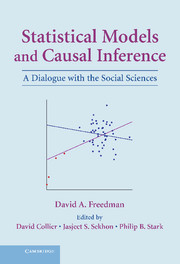Book contents
- Frontmatter
- Contents
- Preface
- Editors' Introduction: Inference and Shoe Leather
- Part I Statistical Modeling: Foundations and Limitations
- Part II Studies in Political Science, Public Policy, and Epidemiology
- Part III New Developments: Progress or Regress?
- 12 On Regression Adjustments in Experiments with Several Treatments
- 13 Randomization Does Not Justify Logistic Regression
- 14 The Grand Leap
- 15 On Specifying Graphical Models for Causation, and the Identification Problem
- 16 Weighting Regressions by Propensity Scores
- 17 On the So-Called “Huber Sandwich Estimator” and “Robust Standard Errors”
- 18 Endogeneity in Probit Response Models
- 19 Diagnostics Cannot Have Much Power Against General Alternatives
- Part IV Shoe Leather Revisited
- References and Further Reading
- Index
12 - On Regression Adjustments in Experiments with Several Treatments
Published online by Cambridge University Press: 05 June 2012
- Frontmatter
- Contents
- Preface
- Editors' Introduction: Inference and Shoe Leather
- Part I Statistical Modeling: Foundations and Limitations
- Part II Studies in Political Science, Public Policy, and Epidemiology
- Part III New Developments: Progress or Regress?
- 12 On Regression Adjustments in Experiments with Several Treatments
- 13 Randomization Does Not Justify Logistic Regression
- 14 The Grand Leap
- 15 On Specifying Graphical Models for Causation, and the Identification Problem
- 16 Weighting Regressions by Propensity Scores
- 17 On the So-Called “Huber Sandwich Estimator” and “Robust Standard Errors”
- 18 Endogeneity in Probit Response Models
- 19 Diagnostics Cannot Have Much Power Against General Alternatives
- Part IV Shoe Leather Revisited
- References and Further Reading
- Index
Summary
Abstract. Regression adjustments are often made to experimental data to address confounders that may not be balanced by randomization. Since randomization does not justify the models, bias is likely; nor are the usual variance calculations to be trusted. Here, we evaluate regression adjustments using Neyman's non-parametric model. Previous results are generalized, and more intuitive proofs are given. A bias term is isolated, and conditions are given for unbiased estimation in finite samples.
Introduction
Data from randomized controlled experiments (including clinical trials) are often analyzed using regression models and the like. The behavior of the estimates can be calibrated using the non-parametric model in Neyman (1923), where each subject has potential responses to several possible treatments. Only one response can be observed, according to the subject's assignment; the other potential responses must then remain unobserved. Covariates are measured for each subject and may be entered into the regression, perhaps with the hope of improving precision by adjusting the data to compensate for minor imbalances in the assignment groups.
As discussed in Freedman (2006b [Chapter 17], 2008a), randomization does not justify the regression model, so that bias can be expected, and the usual formulas do not give the right variances. Moreover, regression need not improve precision. Here, we extend some of those results, with proofs that are more intuitive.
- Type
- Chapter
- Information
- Statistical Models and Causal InferenceA Dialogue with the Social Sciences, pp. 195 - 218Publisher: Cambridge University PressPrint publication year: 2009

